You already know that visuals are an effective type of content when it comes to user engagement and communication. But the real question is, do visuals improve conversion? In fact, do visuals affect buying decisions at all?
You see, modern buyers expect more subtle selling methods. Before any selling takes place, buyers today demand relationship building, nurturing, and value-based interactions first. As you often hear, selling is like a relationship and no one wants to get married on the first date.
Is there a way to boost your bottom line while avoiding the yucky aspects of selling?
Visual influence and visual decision making are happening now.Click To TweetYour job as a marketer is to cut through the noise and use the power of the internet to interact with your audience in a way that fosters connections. And, one effective way to improve conversions is through visual content marketing.
What is Visual Content Marketing?
Visual content marketing is the use of visual design elements rather than text alone to communicate valuable, relevant information to attract and retain an audience, which ultimately drives action (and eventually conversion). Textual content is usually involved in the visuals but isn’t the primary element.
Examples of visual content marketing include:
- infographics
- charts
- original graphics
- videos
- presentations
- stock photos
- GIFs
- memes
According to Venngage’s annual survey on visual content marketing in 2021, the majority of respondents said that 91-100% of their content contained visuals. Visuals play an increasingly bigger role in content marketing strategy each year.
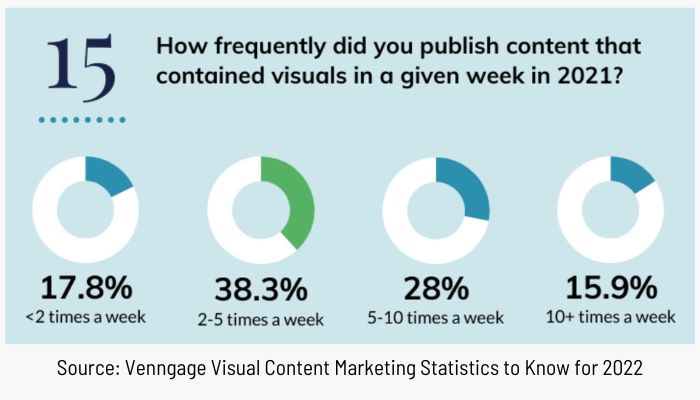
Here are a few other noteworthy tidbits that the Venngage survey discovered:
- Original graphics performed best; stock photos performed the worst
- About 24% of respondents spent 2-5 hours a week on producing visual content
- The biggest struggle with producing visual content was producing it consistently
Now that you’re more familiar with visual content marketing, let’s discuss what it means to your business.
What Motivates People to Buy?
Before you understand the correlation between visual content and sales, you must know a bit about what makes people buy.
There are many factors at play when someone makes a purchase. However, without exception, every purchase decision begins with a buyer’s current dissatisfaction. With that dissatisfaction comes a desire to right what’s wrong with a future promise. Together, the dissatisfaction and the future promise create the motivation to buy.
Every purchase decision begins with a buyer’s current dissatisfaction.Click To TweetPerhaps the more appropriate question is: what motivates people to buy from you?
Beliefs about you and your offerings affect whether or not people buy from you. For instance, if your potential customer believes your offer is beneficial or that you are good and align with their values, then they’ll move closer to buying from you.
The opposite is also true. When your potential customer believes you or your product are bad, they will move away from buying from you.
Is it as simple as that? Let’s dig a little deeper.
The Six Triggers that Influence People to Become Buyers
According to marketing and psychology professor Robert Cialdini, there are six principles to persuade people to say ‘yes’ to you.
I’m going to briefly discuss his work here, but you can (and should!) read more of his ideas on his website.
- Reciprocity
- Scarcity
- Authority
- Consistency
- Liking
- Consensus
Reciprocity refers to a person’s perception after you give them something and they feel compelled to give something back in return.
Scarcity is another word for FOMO, Fear of Missing Out. People don’t want to bypass an opportunity because they worry they’ll miss out. When resources are scarce, people find them more desirable.
Authority is when a person is more likely to say yes to you because you’re coming from a position of expertise and experience. People trust authoritative figures and prefer to follow their lead.
Consistency means that people will go to great lengths to appear consistent in their words and actions. Even small gestures of commitment make them more likely to buy from you, such as signing up for your newsletter, trying a sample or free trial, or free return shipping.
Liking is probably the influence trigger you’ve experienced the most frequently. It simply means that people are more likely to say yes to you if they feel a connection to you or your brand. As Cialdini points out, there are three important factors when it comes to liking. We like people who:
- Are similar to us;
- Pay us compliments; and,
- Cooperate with us toward mutual goals.
Consensus is about people looking to the actions and behaviors of others to determine their own, especially if those other people are similar and higher in number.
Now, ask yourself: is there a way to implement these triggers online and from a visual marketing perspective? The answer is yes.
Why Visual Content Affects Buying Decisions
Previously I discussed how emotions affect purchase decisions and how visuals affect emotions. And, now you can see the connection between beliefs, attitudes, and certain psychological triggers that lead people to buy.
Taking these factors into consideration, visual content improves conversion rates since it:
- elicits emotional responses from your audience;
- helps form beliefs about your brand and offerings; and,
- triggers psychological principles that influence purchases.
Here’s a real-life example of visuals affecting decisions.
My husband loves the men’s clothing brand Mizzen + Main. He awaits their sales announcements like a kid waiting for Christmas morning to arrive.
Whenever they finally send him an email with their latest sales pitch, he obsesses over making a purchase. He cannot resist their story and their sleek, high-performance, easy-care clothes that are made in America. All of these aspects are expressed through Mizzen + Main’s visual content, which appeals to my husband’s emotions, beliefs, and desire to embody his values. (Think about the persuasion factors mentioned above!)
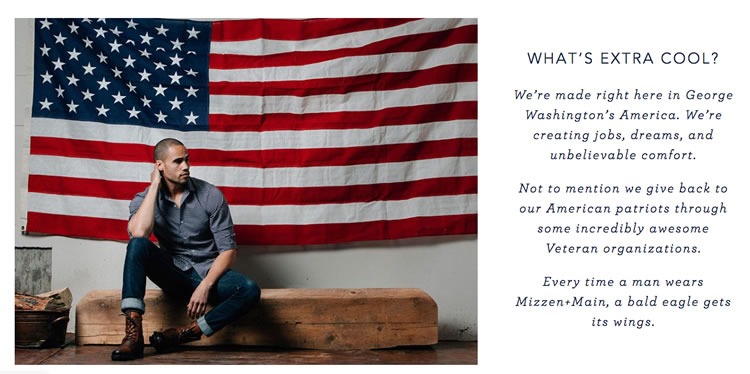
Here’s the funny part…My husband is so emotionally connected to what the brand represents that he repeatedly purchases their products, ALTHOUGH HE DOESN’T FIT IN THEIR CLOTHES!
Mizzen + Main’s visual content must be effective when it can motivate a person to buy clothes that don’t fit.
So, how can you make visuals improve your marketing?
5 Ways to Use Visuals to Improve Conversions
Turning website visitors into leads and leads into buyers isn’t easy for most small business owners. That’s why it’s helpful to discover ways to boost conversions. Read on to learn how you can use visuals to get more opt-ins, webinar sign-ups, downloads, and sales!
1) Educate Your Audience
Research shows that the human brain processes visuals faster and that we learn better through visuals. That’s why visuals work so well to educate, inform, and teach your audience.
What your audience doesn’t know, could hurt them! Provide information about their industry and niche while also explaining your brand and offerings. Educating your audience is critical, especially during their early interactions with you. The more value you provide, the more connected people will become.
Offering consistent value and knowledge to your audience also increases your authority and encourages feelings of reciprocity.
Educating your audience is critical, especially during their early interactions with you.Click To TweetMost people won’t buy from you unless they are aware of the problem, believe they have the problem and feel you’re the person who can alleviate their problem. To help with this, low barrier content educates your audience at the top and middle of your sales funnel.
Here are a few suggestions for areas of your business that may benefit from visual explanation:
Brand
- Mission
- Purpose
- Story
- Values
- Personality
Offerings
- Product/Service description
- Benefits
- Before and After
Example – Squatty Potty
The video for Squatty Potty likely needs no introduction. If you’re unaware of the product, it’s a footstool that helps you poop better.
In the video, the Prince of Poop explains the Squatty Potty via a unicorn who poops rainbow-colored soft serve ice cream. Seem far-fetched? Perhaps.
However, the video not only explained the product in a way that people understood but also with fun and humor. It was the perfect visual to educate while also entertaining. And that’s a powerful combination.
With over 100 million views, this video about pooping went viral.
By depicting the “before and after” states of the unicorn, the product video successfully educates viewers about how the Squatty Potty works and why it’s needed—in a completely memorable, relatable way.
What about sales? Squatty Potty is one of the most successful Shark Tank startups with an estimated $1.2 million in sales in 2016.
2) Inspire Trust of Your Brand and Offer
Trust is at the center of conversion optimization. Sales rely on trust—as well as earning and keeping that trust.
Unfortunately for digital marketers, online ads aren’t the most trusted. When it comes to purchasing, people trust offline ads the most. I’m referring to ads in print, on tv, and via snail mail. (Pop-up ads and online banners fell at the bottom of the list.)
While we have no data about their trust of newspaper journalism, consumers do trust newspapers and magazines more than any other advertising channel at the point in time that matters most to marketers — when they are making a purchase decision.
– MarketingSherpa
Though the most trustworthy advertisement types were not digital, they were almost all highly visual in nature: newspapers, magazines, catalogs, billboards, and tv commercials.

What’s an online marketer to do?
Try to capitalize on the Authority trigger by emphasizing social proof. Use product images, photos and names of people, and logos.
Showing the faces, names, and logos of customers suggest that you’re endorsed by real-life people and organizations, which we know is a strong factor in purchase decisions. Real-life faces and names also humanize your business, which inspires feelings of trust and dependability.
Examples of ways to boost trust:
- Customer reviews
- Client testimonials
- Media mentions
- Influencer recommendations
- Certifications, verifications
- Trust badges
Photos and videos go a long way in making your brand more credible and relatable.
Example – Proof
Proof is an app that displays verified recent customer activity notifications on your website. These notifications display the location, name, and photo for each buyer/conversion. The strategy is to increase your website conversions with social proof.

The app itself is an example of how you might use sign-ups or purchases in a manner that influences current website visitors to buy.
However, the company also does a great job of strategically using visuals to build trust in their brand and app.
For instance, the website displays photos and names of well-known business leaders with their Proof testimonials.
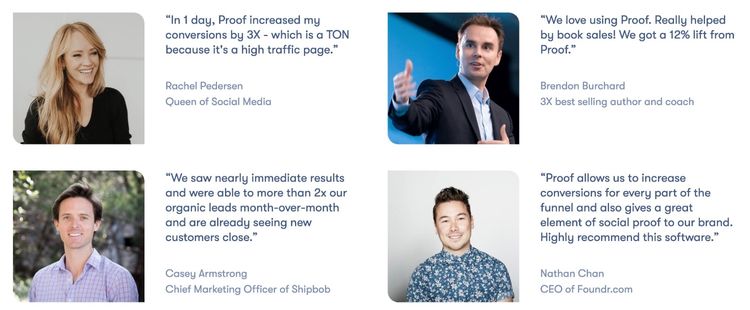
The company also displays logos on their website to boost their authority and the trust factor.
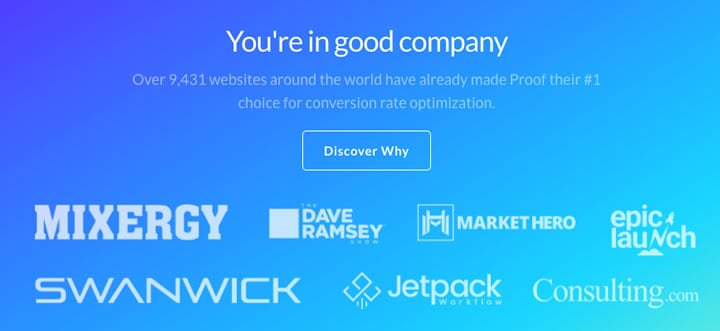
3) Connect Emotionally With Your Community
As Moz points out, consumers desire a more emotional connection these days. Thus, businesses that can genuinely connect with their customers and community will have a strategic advantage over those who don’t.
I completely agree with this viewpoint! Connecting with your audience on a more emotional, personal level will make your business stand out. I call this Y.O.U. Marketing. Your Original Uniqueness attracts the right people to you, in turn building a community of avid supporters while discouraging those not meant to be part of your community.
Visuals have the power to evoke emotion and express your message at a deeper level. Whether profound or humorous, images connect with your audience better, faster, and deeper than text alone.
Examples – Images Versus No images When it Comes to Connecting
How do you feel when you see these Instagram images? What do you think about the brands? Do you connect with their visuals? I certainly do!

Now, take a look these feeds. What’s the impression you get? Do you feel a connection? I’m sure you can see the difference!
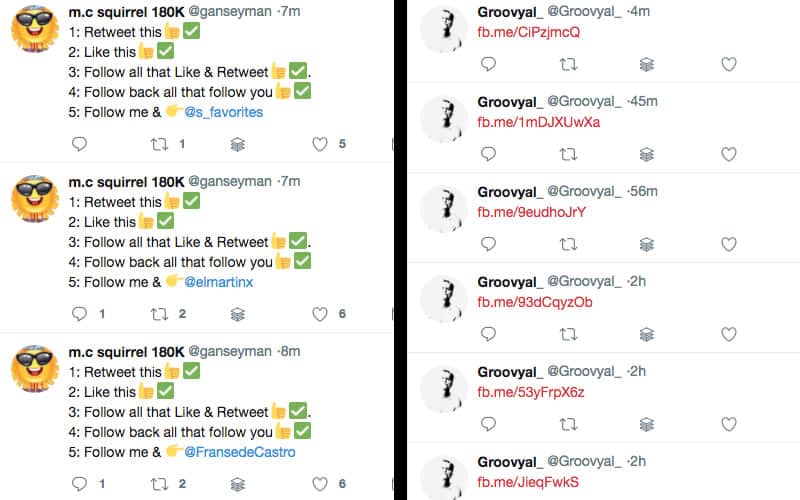
When people relate to your message, there is a greater chance that they’ll like you and your business. That reminds us of the Liking persuasion trigger. That like factor can often transfer from you/your brand to the products and services you offer.
You are the content you share. In an online world, your audience only knows what you reveal to them. If you expect to form connections that build a community, then your content needs to strike an emotional chord. Visuals reinforce your message and make striking that chord easier.
Remember the story above about my husband? Although he does love Mizzen + Main clothes, it’s their message that resonates with him. And, that message comes across in their visuals.
4) Attract Attention
Conversion rates for companies using custom visual content are seven times higher. But, if people can’t find you, it’s going to be impossible to improve your conversions. Here’s how visuals boost your visibility.
Blog
Including images in your blog posts is one SEO blogging tip that pleases search engines and your readers. The highest ranking blogs have images every 350 words. Plus, images in your blog increase readability, credibility, engagement, and content effectiveness.

Search Engine Optimization
Every time you use an image on your site, you get the chance to create a descriptive file name and alt text. Don’t overlook these two benefits. By using your keywords in the file name and alt text, you’re helping search engines find you.
Captions
Images give you the opportunity to use captions. According to Kissmetrics, captions are read 300% more than body copy. You’ll enjoy increased attention by including captions!
Social Media
Images in your social media posts draw attention since they are more noticeable in the news feed than text-only posts. Studies show that posts with images get more engagement too, which means you have a better chance of algorithms displaying your content to fans.
Visuals that aren't relevant can hurt your visibility and repel potential fans.Click To TweetYou can’t go wrong when you use images in your content strategy…unless the visual you choose doesn’t coincide with your topic or is inappropriate! Visuals that don’t make sense contextually could turn off your audience, so beware.
5) Show, Don’t Tell
There’s a writing technique called “show, don’t tell.” The principle is fairly straightforward. Rather than describe things to your readers, use actions, feelings, and visuals so that your audience experiences the story and content.
I consider show-don’t-tell writing to appeal to people’s needs for visualization and emotional connection. As you might guess, visuals are terrific for showing!
Example – Storytelling
Storytelling is one example of show-don’t-tell writing. When presented with a story, your audience can better imagine and relate to whatever concept or feeling you want to convey. It’s the way we work as humans.
According to Buffer, a story is a connection between cause and effect, which is how humans think.
“Whenever we hear a story, we want to relate it to one of our existing experiences. That’s why metaphors work so well with us. Whilst we are busy searching for a similar experience in our brains, we activate a part called insula, which helps us relate to that same experience of pain, joy, disgust or else.” – Buffer
So where do visuals fit into this?
We know that 83% of learning is visual and that the brain processes images 60,000 times faster than text. So, when you see graphical content, you associate it with a memory, experience, or emotion. Once your brain perceives the story on this level and relates to it, there’s a greater understanding happening that just doesn’t occur as effectively with text.
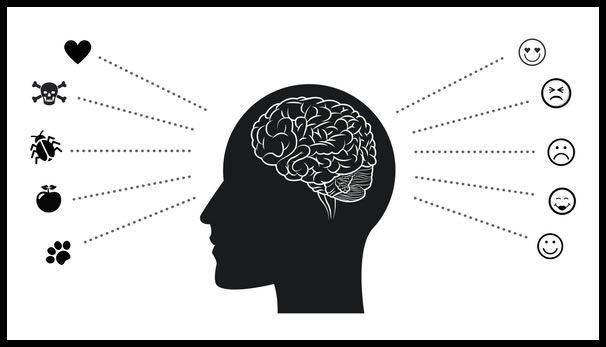
Apply this scenario to any conversion opportunity in your business. If you could get your audience to relate to your offer on this level of connection, don’t you believe they’d be more inclined to say yes?
Just Because You Use Visuals Doesn’t Mean Your Conversions Will Increase – But It Could Help
Posting a few visuals online isn’t going to make sales cascade in and grey skies blue. That’s not how it works.
There’s no perfect method for improving your conversions. Content marketing takes time…we’re talking six months to a year before you notice an improvement.
But I’ve found that visuals have increased the effectiveness of my content efforts. I notice the positive results in higher social shares, blog readership, and traffic. And, that’s why I wanted to cover this topic.
“Visual influence” may help make the difference in your business if you’ve been struggling with low conversion rates.
CrowdRiff summarizes it best: “visual decision making is happening now.”
UPDATED JANUARY 27, 2023 | ORIGINALLY PUBLISHED NOVEMBER 16, 2017

Wonderful post, and I especially liked the following::
“You ARE the content you post… your audience only knows what you reveal to them. If you expect to form connections… your content needs to strike a chord. Visuals reinforce your message and make striking that chord easier.”
Thanks for a very thorough and well-written post here! 👍